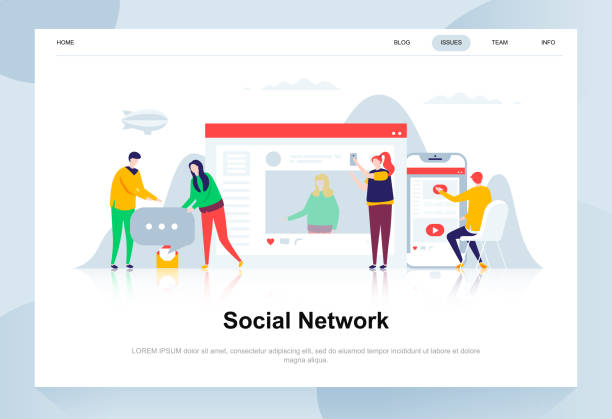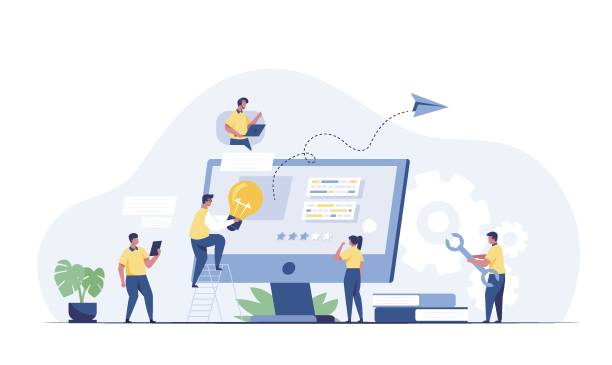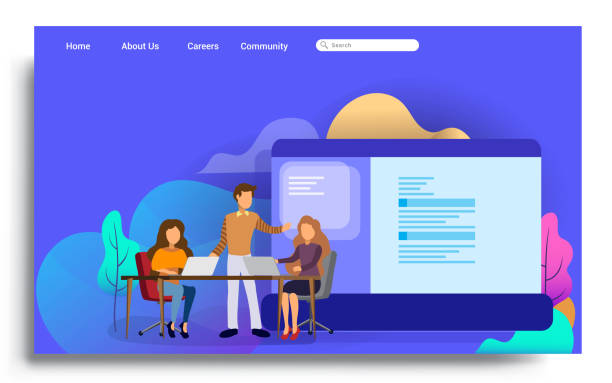The Importance of Secure Website Design in the Current Era

In today’s fast-paced world, an online presence is a necessity for every business and individual.
But with the expansion of the digital space, cyber threats have increased proportionally.
#CyberSecurity, #DataProtection, and #ReliableWebsiteDesign are no longer luxury options; rather, they are the backbone of the stability and credibility of an online presence.
Secure website design not only protects your users’ and business’s sensitive information but also brings trust and customer loyalty.
Cyber attacks can lead to data loss, damage to brand reputation, and even heavy financial losses.
For this reason, a deep understanding of the principles of secure website design and their implementation from the very initial stages of website development is of vital importance.
Without adhering to these principles, any website, no matter how beautiful and functional, will be at serious risk.
This is an analytical topic that requires careful examination to understand its various dimensions and arrive at practical solutions.
Losing user information or disclosing financial data can irrevocably harm a brand, so investing in website security from the outset is smart.
The importance of this issue is such that many large companies, after experiencing severe cyber attacks, have moved towards a complete overhaul of their security structure.
This shows that a proactive approach and attention to secure website design are much more effective than post-incident reactions.
In fact, security should be an integral part of the Software Development Life Cycle (SDLC).
Are you dissatisfied with your e-commerce site’s low sales?
RasaWeb is your solution for having a professional and high-selling e-commerce site.
✅ Significant increase in sales and revenue
✅ Easy and enjoyable shopping experience for customers
⚡ Get a free consultation from RasaWeb right now!
Common Cyber Threats and Ways to Counter Them

Understanding cyber threats is the first step towards secure website design.
#SQL_Injection_attacks, #XSS (Cross-Site Scripting), #DDoS (Distributed Denial of Service), and #Phishing are just a few examples of the most common threats that websites face.
A SQL Injection attack allows an attacker to gain access to the database by injecting malicious SQL code into website inputs.
To counter this attack, using Prepared Statements and precise input validation is essential.
XSS attacks steal user information by injecting malicious scripts into web pages in users’ browsers; filtering and Output Encoding user inputs can prevent these attacks.
DDoS attacks send a huge volume of artificial traffic to the server, causing the website to shut down; using CDNs (Content Delivery Networks) and DDoS protection services are effective solutions to counter this threat.
Phishing also obtains sensitive user information through fake websites or deceptive emails; increasing user awareness and using valid SSL/TLS certificates to demonstrate website authenticity are very important.
This section descriptively introduces various types of attacks and provides general solutions so that users can become familiar with the main areas of website security.
Each of these threats can severely damage a website’s infrastructure and credibility, so understanding how they work and implementing appropriate defenses is vital for every developer and website administrator.
These explanations can be useful not only for specialists but also for ordinary users so that they can detect suspicious behaviors and protect themselves.
The Role of Security Protocols in Website Design

In the world of secure website design, security protocols play a vital role.
#HTTPS, #SSL/TLS, #HSTS, and #CSP are among these protocols that guarantee the security of your website’s communications and content.
HTTPS (Hypertext Transfer Protocol Secure) is the secure version of HTTP that encrypts communications between the user’s browser and the server using SSL/TLS (Secure Sockets Layer/Transport Layer Security).
This encryption prevents eavesdropping, data tampering, and identity spoofing and is essential for any website that processes sensitive user information (such as login forms, payment information, etc.).
HSTS (HTTP Strict Transport Security) is a security header that instructs browsers to always use HTTPS connections for your website and prevents any attempts to use regular HTTP, even if the user accidentally enters the HTTP protocol.
CSP (Content Security Policy) is also a powerful tool that allows developers to restrict the resources a web page can load (such as scripts, images, stylesheets, and fonts).
This protocol effectively prevents code injection attacks like XSS.
Proper implementation of these protocols is a significant step towards increasing the overall security of the website and enhancing website security.
This is a specialized section that delves into the technical details of the protocols.
Awareness of these protocols and how to implement them is essential for anyone involved in website security provision.
Using these protocols not only increases security but also positively impacts site SEO, as Google gives higher priority to HTTPS websites.
| Protocol | Main Use | Advantages | Disadvantages/Complexity |
|---|---|---|---|
| HTTPS | Encrypting browser and server communications | Increased user trust, improved SEO, prevention of eavesdropping and data manipulation | Requires SSL/TLS certificate, slight performance overhead (usually negligible) |
| HSTS | Enforcing HTTPS usage | Prevents Downgrade attacks, protects against Man-in-the-Middle attacks | If there is a certificate issue, the website becomes inaccessible for a specified period |
| CSP | Controlling loadable resources by the page | Powerful prevention of XSS, reduced risk of code injection | Complex implementation, requires thorough testing to prevent breaking functionalities |
The Importance of Continuous Updates and Vulnerability Management

One of the most important aspects of secure website design is the commitment to continuous updates and active vulnerability management.
#SystemUpdates, #SecurityPatches, and #VulnerabilityManagement should be an integral part of any website’s maintenance routine.
Software, whether server operating systems, CMS (like WordPress, Joomla), plugins and themes, or development libraries, are constantly evolving, and new security vulnerabilities are discovered in them.
Hackers are continuously searching for these vulnerabilities to exploit them for system penetration.
Therefore, timely application of security patches and software updates is vital.
This includes updating the CMS core, all installed plugins and themes, and also updating the server operating system and related software such as PHP, Nginx, Apache, and the database.
Furthermore, vulnerability scanning tools should be used to identify weaknesses in the website’s code and configuration, and discovered issues should be promptly resolved.
This is a practical guide that emphasizes the importance of active and dynamic maintenance.
Ignoring updates can open the door for attackers and render all previous efforts for secure website design ineffective.
This proactive approach significantly helps in maintaining website security in the long term.
A website that is not regularly updated is like a house with open windows, where burglars can easily enter.
Are you worried about losing customers because you don’t have a professional e-commerce site?
With e-commerce site design by RasaWeb, forget these worries!
✅ Significant increase in sales and visitor-to-customer conversion rate
✅ Professional and user-friendly design that gains customer trust
⚡ Get a free consultation from RasaWeb
Identity and Access Management in Web Systems

Identity and Access Management (IAM) is the backbone of secure website design.
#UserManagement, #StrongAuthentication, and #AccessControl are key components of this system.
Implementing a strong authentication system involves using complex passwords, regular password change policies, and preferably two-factor authentication (2FA).
2FA provides an additional layer of security, making unauthorized access difficult even if the user’s password is leaked.
Furthermore, securely storing user passwords in the database is crucial; never store passwords in plain text, but use strong hashing (such as bcrypt) with salt.
Access control also means ensuring that each user or role in the system only has access to the resources and functionalities required to perform their tasks (the principle of least privilege).
This includes precisely defining roles and permissions and correctly implementing them at various levels of the website (database, files, and application functionalities).
Regularly reviewing access logs and unusual activities can also help identify intrusion attempts.
This educational section explains concepts and best practices in IAM so that developers and website administrators can design more secure systems.
Errors in identity and access management can easily lead to internal or external breaches, even if other aspects of website security have been observed.
Therefore, a deep understanding of these concepts is vital for anyone responsible for secure website design.
Data Security and User Privacy

User privacy and data security are among the most important concerns in modern secure website design.
#DataEncryption, #UserPrivacy, and #GDPR_regulations are topics that every website designer must pay special attention to.
Do you know how to best protect user data, both in transit and at rest? Encrypting data during transmission (with HTTPS) and at rest (with database or file encryption) are fundamental principles.
Collecting only necessary information and deleting information that is no longer needed are important principles of risk reduction.
Furthermore, there must be full transparency regarding how data is collected, used, and stored, and users must be given control over their information.
International regulations like GDPR (General Data Protection Regulation) in Europe and CCPA (California Consumer Privacy Act) in California have set stringent standards for the protection of personal data, which must be adhered to by websites dealing with users from these regions.
Non-compliance with these regulations can lead to heavy fines and loss of user trust.
This is a thought-provoking content that encourages the audience to seek optimal solutions.
Many companies still haven’t fully understood the importance of these regulations, which could lead to serious problems in the future.
Website security provision in terms of privacy is not only a legal responsibility but also an ethical commitment to users that directly impacts your website’s credibility and success.
How can we fully protect our users’ data against any misuse, whether from hackers or from ourselves?
Penetration Testing and Periodic Security Assessment

After implementing secure website design, the work is not over; rather, continuous monitoring and evaluation are essential for maintaining security.
#PenetrationTesting, #VulnerabilityScanning, and #PeriodicSecurityAssessment are among the important activities in this area.
Penetration Testing is a process in which security experts (ethical hackers), by simulating real attacks, try to discover existing vulnerabilities in the website and its infrastructure.
These tests can include black-box testing (without prior knowledge of the system) or white-box testing (with access to source code and system information).
The results of penetration testing include a report of discovered vulnerabilities and recommendations for their remediation.
In addition to penetration testing, using automated Vulnerability Scanners can also help identify weaknesses more quickly.
These tools regularly scan the website for known vulnerabilities and provide comprehensive reports.
Periodic security assessments should include reviewing code, server and network configurations, and security policies to ensure that the website is always protected against new threats.
This section reports on the importance and necessity of performing these security tests and reports, which are constantly emphasized in the world of cybersecurity.
Large and small companies must regularly perform these tests to maintain their website security.
These actions not only help identify and resolve issues but also demonstrate an organization’s commitment to website security provision and protecting user data.
This proactive approach is much more effective than reactive responses to attacks.
| Stage | Description | Sample Tools |
|---|---|---|
| Information Gathering | Identifying subdomains, open ports, used technologies | Nmap, Maltego, Sublist3r |
| Vulnerability Scanning | Automated identification of known weaknesses | OWASP ZAP, Nessus, Acunetix |
| Analysis and Exploitation | Validating vulnerabilities and attempting exploitation | Metasploit, Burp Suite |
| Post-Exploitation | Maintaining access, privilege escalation, further information gathering | Mimikatz, Empire |
| Reporting | Documenting findings and providing remediation recommendations | Word processors, custom scripts |
Using Firewalls and Intrusion Detection Systems

In line with secure website design, utilizing firewalls and Intrusion Detection Systems (IDS) or Intrusion Prevention Systems (IPS) is considered specialized and highly critical.
#WebFirewall, #IntrusionDetectionSystem, and #WAF (Web Application Firewall) form your first and second lines of defense.
Firewalls (both hardware and software) filter incoming and outgoing network traffic based on a set of predefined rules.
This filtering can include blocking insecure ports, restricting access from suspicious IP addresses, and controlling the type of allowed traffic.
WAF is specifically designed to protect web applications against common web attacks such as SQL Injection and XSS.
WAFs can inspect traffic at the Application Layer, identify known attack patterns, and block them.
IDS monitors network traffic and systems to identify suspicious activities or violations of security rules and issues alerts if any anomalies are observed.
IPS goes a step further and, in addition to detection, also has the ability to actively prevent attacks.
Proper implementation of these tools requires precise technical knowledge and appropriate configuration to prevent the creation of “security blind spots” and ensure comprehensive website security.
This is a specialized aspect of website security provision that requires deep knowledge of network architecture and communication protocols.
Simultaneous use of firewalls and IDS/IPS creates multiple defensive layers that significantly reduce the likelihood of successful attacks.
Is your company’s website performing as befits your brand? In today’s competitive world, your website is your most important online tool. RasaWeb, specializing in professional corporate website design, helps you to:
✅ Gain customer credibility and trust
✅ Convert website visitors into customers
⚡ Get a free consultation!
Backup and Data Recovery After an Attack

Even with the best secure website design approaches, the likelihood of cyberattacks never reaches zero.
Therefore, having a strong Backup and Disaster Recovery plan is your last line of defense.
#RegularBackup, #DataRecovery, and #ComprehensiveSecurityPlan are key pillars of preparedness for the worst-case scenarios.
Regular and automatic backup of all website data, including databases, files, images, and program codes, should become a habit.
These backups must be stored in a secure location separate from the main server (e.g., in cloud storage or another backup server) to be accessible if the main server is damaged.
Another critical point is periodic testing of the recovery process.
Many organizations back up but never test the recovery process and realize when needed that the backups are corrupt or recovery is not performed correctly.
A comprehensive disaster recovery plan should include detailed steps for recovering systems and data after a security incident, clearly defined responsibilities, and expected timelines for returning to normal operations.
This plan should be regularly updated and practiced.
This is a vital guide that assures you that even after a successful attack, you will be able to restore your website to normal operation and prevent permanent data loss.
This approach also guarantees your website security against unpredictable disasters and is considered an important part of secure website design.
The Future of Secure Website Design and Upcoming Challenges

The future of secure website design comes with new challenges and opportunities that are constantly changing and evolving.
#AI_in_Security, #Blockchain_Security, and #QuantumComputing are topics that cybersecurity specialists should keep in their sights.
With the increasing advancement of Artificial Intelligence and Machine Learning, attackers are using these technologies to make their attacks smarter; for example, automated malware and more sophisticated phishing attacks.
On the other hand, these same technologies can also be used to strengthen security defenses; such as AI-powered intrusion detection systems capable of identifying more complex attack patterns.
Blockchain technology, with its inherent characteristics like immutability and decentralization, has high potential for increasing data security and web authentication and can play an important role in secure website design in the future.
However, quantum computing also poses a new threat to current encryption methods, making the development of Post-Quantum Cryptography algorithms essential.
Another challenge is the increasing complexity of web ecosystems and reliance on cloud services and third-party APIs, which introduce new vulnerabilities.
This is engaging content that explores future trends and emerging challenges in web security.
Website security provision in the future will require a dynamic, creative, and continuous approach to counter evolving threats.
Success in secure website design in the future will require continuous learning and adaptation to new technologies, and it is never a final destination, but rather an endless process.
Frequently Asked Questions
| Question | Answer |
|---|---|
| What is secure website design? | Secure website design is the process in which websites are built considering security principles to be resistant to cyberattacks and to protect user and business information. |
| Why is secure website design highly important? | To prevent unauthorized access to data, sensitive information leaks, malware attacks, loss of user trust, damage to business reputation, and legal consequences resulting from data breaches. |
| What are the most common website vulnerabilities? | SQL Injection, Cross-Site Scripting (XSS), Cross-Site Request Forgery (CSRF), Broken Authentication and Session Management, and Sensitive Data Exposure. |
| How can SQL Injection attacks be prevented? | Using Prepared Statements with parameterized queries, Input Validation, and restricting database access. |
| What are the methods to counter XSS (Cross-Site Scripting) attacks? | User Input Validation, Output Encoding before displaying in HTML, and using Content Security Policy (CSP). |
| What is the role of HTTPS in website security? | HTTPS, using an SSL/TLS certificate, encrypts the communication between the user’s browser and the website server, preventing eavesdropping, tampering, or spoofing of data. |
| What are the best practices for user password management? | Enforcing strong passwords (a combination of letters, numbers, and symbols), hashing passwords instead of direct storage (with strong algorithms like bcrypt), and enabling two-factor authentication (2FA). |
| What is the importance of User Input Validation? | Input validation prevents malicious or unexpected data from entering the system, which can lead to vulnerabilities such as SQL Injection or XSS. |
| How do regular security reviews and audits impact site security? | These reviews help in early identification of vulnerabilities and security weaknesses, allowing them to be fixed before they can be exploited. |
| What is the application of Web Application Firewall (WAF) in secure website design? | WAF acts as a protective layer between the user and the website, analyzing incoming traffic, and identifying and blocking common web attacks like SQL Injection and XSS. |
And other services of Rasa Web Advertising Agency in the field of advertising
Smart Digital Advertising: An effective tool for online growth by optimizing key pages.
Smart Data Analysis: A new service for increasing website traffic through the use of real data.
Smart Content Strategy: A new service for increasing website traffic through intelligent data analysis.
Smart SEO: A new service for increasing website traffic through SEO-driven content strategy.
Smart Conversion Rate Optimization: Revolutionize SEO ranking improvement with custom programming.
And over a hundred other services in the field of internet advertising, advertising consultation, and organizational solutions
Internet Advertising | Advertising Strategy | Advertorial
Resources
- Secure Website Design – HostIran
- Website Security Tips – WebRamz
- Secure Website Design Guide – Rayvarz
- Website Security Checklist – Nilasoft
? To elevate your business in the digital world and be seen at the top, RasaWeb Afarin, a specialist in digital marketing services including corporate website design, is your professional partner.
📍 Tehran, Mirdamad Street, next to Bank Markazi, Kazeroun Jonoubi Alley, Ramin Alley No. 6



